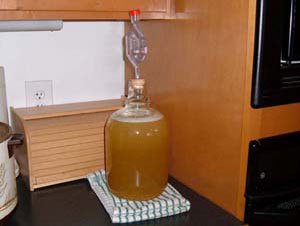- The methods described here are illustrated in the following University of Minnesota Instructional Poster “Basic Mead Making” Download a .pdf here.
This is one method. There are many methods and recipies for mead making.
Recipes
For a 1 Gallon batch:
3 pounds honey,
1 Pkg. Yeast,
Fermaid K,
3 quarts water
For a 5 Gallon batch:
15 pounds honey,
2 Pkg. Yeast,
Fermaid K,
4 gallons water
Typical batch sizes are 1 or 5 gallon. Obtain glass carboys to hold the size of
the batch you want to make. In the following descriptions the 1 gallon amounts will be given in text and the 5 gallon amounts will be in [ ].

1. First gather equipment: 2-Carboys, vapor lock & cork, siphon hose, racking cane with bottom cap, sauce pan, candy thermometer, funnel, ladle, bottles and labels.
Ingredients: Honey, yeast, Fermaid K.

2. Honey and yeast are the two main things that effect the taste of your mead. Try
different varieties of honeys as well as different yeast. Wildflower honey with Cote des Blancs yeast is a good start.

3. Sterilize all equipment before use. Use a sterilizing agent from a wine supply store or household bleach. Follow directions on product.
If water is not sterile, boil first then cool.
Do not use distilled water.

4.Stir 3# [15#] of honey with 2 cups [2 quarts] water in sauce pan and heat to
160ºF. Remove from heat and let cool for 15 minutes.
Put 1 quart [1 gallon] cool water in carboy.

5. Pour honey & water mixture slowly into the carboy. Add cold water to bring level to 1 gallon [5 gallons].

6. Put 1 or 2 teaspoons of water in the vapor lock and put it on the carboy and wait until temperature falls below 80ºF.

7. Add Fermaid K (or combination of yeast energizer and yeast nutrient) according to package directions. Shake vigorously then put vapor lock back on.

8. Prepare yeast. Have 1/4 cup of water at 100-105ºF. Sprinkle yeast on top and let set undisturbed for 15 minutes. Then stir. For best results when using more than 1 package, do them separately.

9. Pitch the yeast. Remove the vapor lock and pour the prepared yeast into the carboy. Replace the vapor lock.

10. Put the carboy in a safe place (where it won’t get broken) at cool room temp 60ºF – 75ºF). Within 48 hours there will be bubbles coming from the vapor lock. This means the yeast is working.

11. When bubbling stops and sediment appears on the bottom (1-3 months) you should rack the mead. This is the process of siphoning the mead off the top into a clean carboy leaving the sediment behind.

12. Place the full carboy on the counter.
Place the empty sterile carboy on a
chair. Sterilize siphon tube and racking
cane and fill with water.
Hold finger over the end of tube, place
cane in full carboy (bottom cap should
hold it off the bottom), place end of tube
over a glass and release. When water
is out of tube and mead reaches the
end place the tube into empty carboy.
Lift cane to stop flow when sediment
begins to enter. Put vapor lock into new
carboy and return to safe place.
When sediment appears again (2 weeks)
rack the mead again. Continue this until
no more sediment appears. Rack one
more time into carboy then in 2 weeks you
can rack into bottles and label.

13.
When sediment appears again (2 weeks)
rack the mead again. Continue this until
no more sediment appears. Rack one
more time into carboy then in 2 weeks you
can rack into bottles and label.
Source:
University of Minnesota Instructional Poster #158, Gary S. Reuter and Marla Spivak, Department of Entomology
